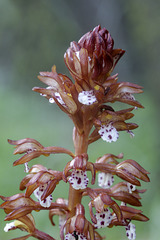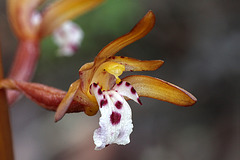RHH's photos with the keyword: maculata
Spotted Coralroot
| 19 Jul 2019 |
|
|
|
Coralroots are strange plants lacking both leaves and chlorophyll. As a result they often grow in dark forests where nothing else will grow. These Spotted Coralroots were photographed in a forest along the Columbia River. They have yellow stems but the species is variable and often has red, brown, pink or even white stems.
Western Spotted Coralroot
| 15 Jun 2019 |
|
|
|
We are down near the Oregon-California border where we spent the night and will be continuing into California in a little while to Jedediah Smith Redwoods State Park. We spent a wonderful day yesterday traveling down the Oregon coast from Cape Perpetua to Brookings. We did some hiking, visited several lighthouses, walked the beaches, explored the tidepools along the coast, and watched the sunset at Meyer's Creek north of Brookings. The day started foggy and gray but soon turned sunny, and though very windy was pleasant.
These photos were taken last week in eastern Washington near the town of Leavenworth, a faux German town that is a popular tourist destination. I did not stop in the town but continued orchid hunting at several locations near Leavenworth. Coralroots are strange orchids that have no leaves and most of them no chlorophyll. They often grow in dark forests with little undergrowth, those there were in a somewhat brighter location. Washington has four species of Coralroots including the Western Spotted, but they were very sparse this year in all the locations I visited.
Western Spotted Coralroot
| 15 Jun 2019 |
|
|
|
These are the flowers of the Western Spotted Coralroot which is nothing more (above ground) than a flowering stem since they are leafless and without chlorophyll. They were photographed in eastern Washington near Leavenworth.
Western Spotted Coralroot
| 15 Jun 2019 |
|
|
|
Coralroots are strange plants, little more than a flowering stem since they are leafless and without chlorophyll. These were photographed near Leavenworth, Washington, on the east side of the Cascades, but grow all over the Pacific Northwest.
Western Spotted Coralroot
| 27 Apr 2015 |
|
|
|
This was the second orchid of the new season, the Western Spotted Coralroot, Corallorhiza maculata var. occidentalis, another leafless orchid without chlorophyll that depends for its nourishment on a complex relationship with a soil fungus. This example was photographed in Washington Park on Fidalgo Island, but it is a common orchid even at higher elevations.
Corallorhiza maculata var. occidentalis
| 11 Feb 2015 |
|
|
|
This is the Western Spotted Coralroot, a mycotrophic plant without chlorophyll or leaves, photographed along Padden Ridge above Lake Padden. This variety of the Spotted Coralroot blooms earlier than the ordinary variety, is found only in the west, and is distinguished not only by its earlier bloom time but by the rounded lip. The ordinary variety has a lip that is straight-sided. This is one of the more common native orchids in our area.
Spotted Coralroot, Red-stemmed Form
| 16 Jul 2014 |
|
|
|
This is the red-stemmed form of the Spotted Coralroot, Corallorhiza maculata var. maculata fma. rubra. It was photographed on an orchid-hunting excursion to eastern Washington some weeks ago. It was only when I was getting the photo ready to post that I noticed the caterpillar on one of the flower stems. Do you see it?
Western Spotted Coralroot, Golden Form
| 18 Jun 2014 |
|
|
|
This is Corallorhiza maculata var. occidentalis fma. aurea, the gold form of a species that is usually a reddish-tan color. This was photographed by my wife in eastern Washington where we found some very unusual color forms of this species. Like all the Coralroots, it is without chlorophyll and without leaves.
Corallorhiza maculata var. occidentalis
| 21 May 2014 |
|
|
|
I've posted several pictures of Coralroots recently and thought I'd post a picture showing how they grow. These are the Western Spotted Coralroot growing in a nice clump in Washington Park near Anacortes. Notice the lack of leaves (they are leafless) and they are without chlorophyll too.
This will be my last post for a couple of days. I am leaving shortly on a camping trip with a group of 6-8th graders (I'm one of the chaperones) and will catch everyone up with commenting when I return. Until then, may you all have a good day and a good rest of the week.
Corallorhiza maculata var. occidentalis fma. immac…
| 21 May 2014 |
|
|
|
This is a rare color form of a very common native orchid, another Coralroot, the Western Spotted Coralroot. Like all the other Coralroots, it has no leaves or chlorophyll and lives off decaying material in the soil via a relationship with a fungus. The ordinary form of the plant is shown in the inset. This is the "albino" form, lacking the spotting and darker color. It is Corallorhiza (Coralroot) maculata (spotted) var. occidentalis (western) fma. immaculata (unspotted). We have only ever found this once.
Western Spotted Coralroot (Corallorrhiza maculata…
| 26 May 2009 |
|
|
In Explore May 25, 2009, #202 (highest).
Published in an article on the website of the American Orchid Society: www.aos.org/AM/Template.cfm?Section=Home&CONTENTID=78...
We did some hiking today (Memorial Day) in the Chuckanuts and I found two plants of this native orchid species.
Ozette Coralroot (Corallorhiza maculata var. ozett…
| 09 Jun 2009 |
|
|
|
In Explore June 8, 2009, #234.
A single flower of this rare species.
Published in an article on the website of the American Orchid Society: www.aos.org/AM/Template.cfm?Section=Home&CONTENTID=78...
Ozette Coralroot (Corallorhiza maculata var. ozett…
| 09 Jun 2009 |
|
|
In Explore June 8, 2009, #290.
Published in an article on the website of the American Orchid Society: www.aos.org/AM/Template.cfm?Section=Home&CONTENTID=78...
Saturday, June 6, 2009, the Washington Native Orchid Society had a field trip to Whidbey Island in the San Juans. Under the guidance of Chelsea Kieffer from Maryland we examined a new location for this very rare orchid, found only in two locations in western Washington and first described as a new species in 2001. We not only saw this rare species but two other more common Coralroots, a Listera, a Goodyera and some Calypsos (these had gone to seed as had the Listera).
Spotted Coralroot (Corallorrhiza maculata var. mac…
| 12 Jun 2009 |
|
|
In Explore June 11, 2009, #239.
This is the third species of Coralroot we saw on our field trip with the WNOS.
Western Spotted Coralroot
| 07 Jun 2013 |
|
|
|
The Spotted Coralroots, both the ordinary and the western variety are everywhere in the Pacific Northwest forests at this time of the year. It is rare to be out hiking and not see them. This example was photographed near Leavenworth, Washington near where I photographed the Clustered Lady's Slipper. Like all the other Coralroots these are leafless and without chlorophyll and use a fungus to get their nutrients from the soil.
ronaldhanko-orchidhunter.blogspot.com/2013/05/orchid-hunting-in-leavenworth-area.html
Corallorhiza maculata var. occidentalis
| 21 Jul 2011 |
|
This photo was taken by my wife near the place where we took the pictures of the Mountain Lady's Slipper posted a few days ago. I thought the picture especially artistic and worthy of posting. This is the Western Spotted Coralroot, barely distinguishable from the ordinary variety by the shape of the lip.
nativeorchidsofthepacificnorthwest.blogspot.com/2011/07/c...
Corallorhiza maculata var. maculata
| 18 Jul 2011 |
|
|
I'm going to be posting pictures of some of the native orchids we've seen this spring and summer. We've had quite a bit of opportunity to get out and have seen again many of the natives as well as some new species.
This was photographed in Washington Park near Anacortes, a park that receives very high use but has a varied and interesting wildflower population including quite a number of the native orchid species. This is the Spotted Coralroot.
The Coralroots are a group of native orchids that are saprophytes, without chlorophyll and leaves, and which get their nourishment from decaying matter in the soil. They were especially abundant this spring and summer.
There are several varieties of this species, and I am not certain that I've correctly identified the variety since the differences are primarily in the shape of the lip. There are also a number of different color forms, this being the brownish form.
The plants are 18-24 inches tall and the flowers from 1/2 inch to an inch in size. They grow in dry, open woodlands, usually in rather shady areas. For more pictures and in formation see: nativeorchidsofthepacificnorthwest.blogspot.com/2011/06/c... .
Corallorhiza maculata var. occidentalis
| 22 Aug 2011 |
|
This was phgotographed at the Au Sable Institute near Coupeville on Whidbey Island while on a camping trip with a group of young people. We were camped at Fort Ebey and while on a excursion to Port Townsend and Fort Worden, across the Sound, I made a quick side trip to see what was blooming at the Institute.
The Corallorhizas are all leafless plants without chlorophyll that live off decaying material in the soil. Washington has a five diffferent species, often found in dark, dry areas in the forests.
nativeorchidsofthepacificnorthwest.blogspot.com/2011/06/c...
Jump to top
RSS feed- RHH's latest photos with "maculata" - Photos
- ipernity © 2007-2025
- Help & Contact
|
Club news
|
About ipernity
|
History |
ipernity Club & Prices |
Guide of good conduct
Donate | Group guidelines | Privacy policy | Terms of use | Statutes | In memoria -
Facebook
Twitter


















